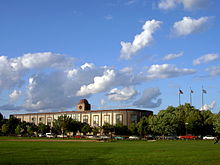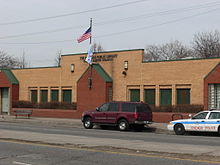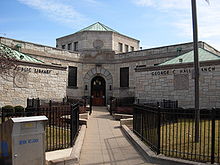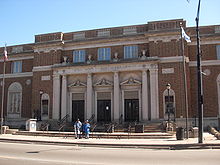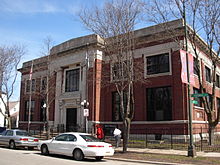- Chicago Public Library
-
Chicago Public Library 
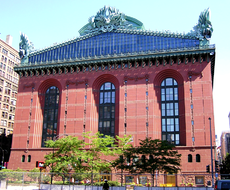
Established 1873 Location Chicago, Illinois Branches 79 Collection Size 5,721,334 volumes (July 2010, ALA data) Access and use Circulation 7.5 million Population served 2.8 million Other information Budget $106,000,000 Director Mary A. Dempsey Website chipublib.org The Chicago Public Library (CPL) is the public library system that serves the City of Chicago in Illinois. It consists of 79 branches, including a central library, two regional libraries, and branches distributed throughout the city.[1]
The American Library Association reports that the library holds 5,721,334 volumes, making it the 30th largest library in the United States by volumes held and the ninth largest public library system in the United States by volumes held. The Chicago Public Library is the second largest library system in Chicago by volumes held (the largest is the University of Chicago Library). The library is the second largest public library system in the Midwest, after the Detroit Public Library.[2]
Contents
History
In the aftermath of the 1871 Great Chicago Fire, Londoner A.H. Burgess, with the aid of Thomas Hughes, drew up what would be called the "English Book Donation," which proposed that England should provide a free library to the burnt-out city. The Chicago Public Library was created directly from the ashes of the great Chicago Fire. After Chicago’s Great Fire of October 8, 1871, A.H. Burgess of London proposed an “English Book Donation." Burgess wrote on December 7, 1871 in the London Daily News that "I propose that England should present a Free Library to Chicago, to remain there as a mark of sympathy now, and a keepsake and a token of true brotherly kindness forever..."[3]
After circulating requests for donations throughout English society, the project donated 8,000 books. Private donors included Queen Victoria, Benjamin Disraeli, Alfred, Lord Tennyson, Robert Browning, John Stuart Mill, John Ruskin, and Matthew Arnold.[4]
In Chicago, city leaders petitioned Mayor Joseph Medill to hold a meeting and establish the library. The meeting led to the Illinois Library Act of 1872, which allowed Illinois cities to establish tax-supported libraries. In April 1872, the Chicago City Council passed an ordinance establishing the Chicago Public Library, and on January 1, 1873, the Chicago Public Library officially opened its doors in an abandoned iron water tank at LaSalle and Adams Streets. The collection included 3,157 volumes. The water tank was 58 feet (18 m) in diameter, 21 feet (6.4 m) high and with a 30-foot (9.1 m) foundation. A two story office building was soon built around it to hold city offices, and a third floor reading room was built for the library.
On October 24, 1873, William Frederick Poole was elected the first head librarian by the library's Board of Directors. Poole was mainly concerned during his tenure on building the circulation. In 1874, circulation services began with 13,000 out of 17,533 available for lending. The library moved from place to place during its first 24 years. Eleven years it spent on the fourth floor of city hall. In 1887, Poole resigned to organize the Newberry Library of Chicago.
On October 15, 1887, Frederick H. Hild was elected the second Librarian of the Chicago Public Library and securing a permanent home was his primary drive. Ten years later, the Central Library was opened. Designed by the Boston firm of Shepley, Rutan and Coolidge in the same academic classical style as their building for the Art Institute, it was located on Michigan Avenue between Washington Street and Randolph Street on land donated by the Grand Army of the Republic, a Civil War Veterans group led by John A. Logan, a Civil War General and U.S. Senator from Illinois. In return for the land the Library was to maintain a Civil War collection and exhibit in a G.A.R. room until the last northern Civil War veteran died. The library would remain on this site for the next 96 years. It is now the Chicago Cultural Center.
Henry E. Legler assumed the leadership of the Chicago Public Library on October 11, 1909. Previously a Wisconsin Progressive, he was well-known as an aggressive advocate of the expansion of library service. In 1916, Legler presented his "Library Plan for the Whole City," the first comprehensive branch library system in the nation. A landmark in library history, the plan called for an extensive network of neighborhood library locations throughout Chicago. The goal of the plan was to bring "library service within the walking distance of home for every person in Chicago who can read or wants to use books." Legler was succeeded by his assistant Carl B. Roden in 1918. Roden served as Chief Librarian until 1950.
The Blackstone Library built in 1904 is one of the oldest libraries in the city
Roden was succeeded in 1951 by Chief Librarian Gertrude E. Gscheidle. During her tenure the Library expanded its service to Chicago's neighborhoods by modernizing its bookmobile services. In the 1960s several new neighborhood branch libraries were constructed or were established in leased storefronts or reading rooms.
The two-story, 62,000-square-foot (5,800 m2) Carter G. Woodson Regional Library, named after the "Father of Modern Black Historiography," opened its doors in December 1975. The library features the Vivian Harsh Research Collection, one of the largest repositories of African-American archival information in the Midwest. A decade later, Chicago Public Library replaced its northwest side regional library when the Conrad Sulzer Regional Library opened to the public in late 1985.
In 1974, the Board of Directors authorized an $11 million renovation of the Central Library. While the restoration of the original central library proved a great success, the collections remained warehoused outside the old library while the City debated the status of the future of the central library. One plan was to move the library to the former Rothchild/Goldblatts Department Store which stood empty on Chicago's State Street and had reverted to City ownership.
The Chicago Sun-Times editorial board and Cindy Pritzker, then President of the Library Board, launched a grassroots campaign to build a new state-of-the-art library. On July 29, 1987, Mayor Harold Washington and the Chicago City Council authorized a design and construction competition for a new, one-and-a-half block $144 million library at 400 South State Street.
Current Services
In 1991, the Harold Washington Library Center, Chicago's new central library, named for the late mayor, opened to the public. It was the world's largest municipal public library at the time of its opening. It is accessible from the Brown, Orange, Purple and new Pink Line trains at the "Library" stop, from the Blue Line at the "LaSalle" and "Jackson" stops, as well as from the Red Line at the "Jackson" stop.
Since 1994 the Chicago Public Library has been led by Commissioner Mary A. Dempsey who was appointed by Chicago Mayor Richard M. Daley. Dempsey launched an aggressive rebuilding project, replacing or rehabilitating the majority of Chicago's neighborhood library branches. Many of the new branches are library-owned full service facilities which replaced older branch libraries or rented storefronts. Others have been constructed in neighborhoods that were not previously served by a branch library. It has been the largest and most successful urban library expansion in recent history.[citation needed]
Some of the free programming the Chicago Public Library offers to its patrons includes: The One Book One Chicago program, The Summer Reading Program, The Adult Summer Reading Program, Bookamania (held every November), Great Kids Museum Passport Program (allows patrons free admission to a variety of Chicago's world-class institutions), and Words & Music Program[5] (which provides patrons with free lawn tickets to selected Ravinia concerts).
The Chicago Public Library offers free lecture series covering a variety of topics including: Law at the Library (a free monthly lecture series that offers participants the opportunity to speak with a legal professional about a variety of legal topics), Money Smart (a series of financial literacy programs), and Author Series.
The Chicago Public Library provides access to a large selection of databases, most of which are also available for use at home or other remote location with a Chicago Public Library card.
Branches
Central Library
Harold Washington Library Center
Regional Libraries
North
South
- Woodson Regional Library
North District
- Albany Park Branch
- Austin-Irving Branch
- Harold Bezazian Branch
- Bucktown-Wicker Park Branch
- Budlong Woods Branch
- Richard M. Daley (West Humboldt Park) Branch [6]
- Dunning Branch
- Edgebrook Branch
- Edgewater Branch (Closed on June 16th, 2011 for Construction of a New Facility)[7]
- Galewood-Mont Clare Branch (Temporarily Relocated) [8]
- Humboldt Park Branch
- Independence Branch
- Jefferson Park Branch
- Lincoln-Belmont Branch
- Lincoln Park Branch
- Logan Square Branch
- Mayfair Branch
- John Merlo Branch
- North Austin Branch
- North Pulaski Branch
- Northtown Branch
- Oriole Park Branch
- Portage-Cragin Branch
- Roden Branch
- Rogers Park Branch
- Uptown Branch
- West Belmont Branch
Central District
- Austin Branch
- Back of the Yards Branch
- Blackstone Branch
- Brighton Park Branch
- Canaryville Branch
- Chicago Bee Branch
- Chinatown Branch
- Richard J. Daley Branch
- Douglass Branch
- Gage Park Branch
- Garfield Ridge Branch
- George Cleveland Hall Branch
- Martin Luther King, Jr. Branch
- Legler Branch
- Little Village Branch [9]
- Rudy Lozano Branch
- Mabel Manning Branch
- McKinley Park Branch
- Near North Branch
- Roosevelt Branch
- Sherman Park Branch
- Toman Branch
- Water Works [10]
- West Chicago Avenue
- West Town Branch [11]
South District
- Altgeld Branch
- Avalon Branch
- Beverly Branch
- Brainerd Branch
- Chicago Lawn Branch
- Clearing Branch
- Bessie Coleman Branch
- Greater Grand Crossing Branch
- Hegewisch Branch
- Jeffery Manor Branch
- Kelly Branch
- Thurgood Marshall Branch
- Mount Greenwood Branch
- Pullman Branch
- Scottsdale Branch
- South Chicago Branch
- South Shore Branch
- Vodak East Side Branch
- Walker Branch
- West Englewood Branch
- West Lawn Branch
- West Pullman Branch
- Wrightwood-Ashburn Branch
- Whitney M. Young, Jr. Branch
New Branches Under Construction
- Edgewater Branch [12]
See also
References
- http://www.chipublib.org/aboutcpl/history/index.php 1870-1899
- http://www.chipublib.org/aboutcpl/history/hist1900.php 1900-1949
- http://www.chipublib.org/aboutcpl/history/hist1950.php 1950-1989
- http://www.chipublib.org/aboutcpl/history/hist1990.php 1990-2004
- http://www.chipublib.org/aboutcpl/history/hist2005.php 2005-2010
- ^ "Annual Report for 2010," Chicago Public Library.
- ^ "The Nation's Largest Libraries: A Listing By Volumes Held" (July 2010), American Library Association.
- ^ Encyclopedia of Library and Information Science (Vol. 5). Ed. Allen Kent. CRC Press, 1970.
- ^ "Library History, 1870-1899." Chicago Public Library.
- ^ "Words and Music". Chicago Public Library website. http://www.chipublib.org/eventsprog/programs/words_music.php. Retrieved 2009-05-08.
- ^ http://www.chipublib.org/branch/details/library/daley-w-humboldt/ Richard M. Daley West Humboldt Park Branch Page
- ^ http://www.chipublib.org/branch/details/library/edgewater/ Edgewater Branch Page
- ^ http://www.chipublib.org/branch/details/library/galewood-mont-clare/ Galewood-Montclare Branch Page
- ^ http://www.chipublib.org/branch/details/library/little-village/ Little Village Branch Library page
- ^ http://www.chipublib.org/branch/details/library/water-works/ Water Works Branch Page
- ^ http://www.chipublib.org/branch/details/library/west-town/ West Town Branch Details
- ^ http://www.pbcchicago.com/content/projects/project_detail.asp?pID=08050 New Edgewater Branch Construction page
External links
- Chicago Public Library website
- Chicago Public Library Android application
- Books catalog
- Map of branch locations
- Carl B Roden Papers at Newberry Library
City of Chicago Chicago metropolitan area · State of Illinois · United States of America Architecture · Beaches · Climate · Colleges and Universities · Community areas · Culture · Demographics · Economy · Flag · Freeways · Geography · Government · History · Landmarks · Literature · Media · Music · Neighborhoods · Parks · Public schools · Skyscrapers · Sports · Theatre · Transportation
 Category ·
Category ·  PortalCategories:
PortalCategories:- Education in Chicago, Illinois
- Public libraries in Illinois
- Public libraries in Chicago, Illinois
Wikimedia Foundation. 2010.


